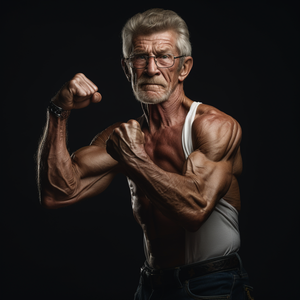Muscles and Aging: Holding onto Strength Through Time
Sep 01, 2023
In the symphony of movement, muscles play a pivotal role. These powerful fibers contract and relax, orchestrating every motion, from the monumental leap of an athlete to the subtle lift of an eyelid. Yet, with the onward march of time, our muscles, much like other body components, undergo transformations. As our series meanders through the myriad terrains of aging, from vision to bone density, and the support of adaptive footwear, we now delve into the dynamic domain of muscles. Let's explore the nuances of their aging process, their undying spirit, and the essence of strength and endurance.
Powerhouses of Movement: Unraveling Muscles
Understanding the basics of muscles sets the stage for the conversation on aging:
- Skeletal Muscles: Attached to bones, they facilitate voluntary movements.
- Smooth Muscles: Found in organs and blood vessels, they control involuntary actions.
- Cardiac Muscle: Exclusive to the heart, it keeps our lifebeat rhythmic and strong.
The Ebbing Tide: Muscle Changes with Age
Muscle transformations over the years encompass:
- Sarcopenia: A gradual loss of muscle mass, often beginning in the 30s and accelerating after 60.
- Strength Decline: Muscle strength tends to decrease with age, particularly if not actively maintained.
- Reduced Muscle Tone: Muscles may appear less firm and can be less responsive.
- Decreased Endurance: Stamina often diminishes, making prolonged activities more taxing.
The Cascade of Consequences: Implications of Muscle Changes
Aging muscles can influence various life aspects:
- Mobility Challenges: Weakness can lead to balance issues, underscoring the importance of reliable adaptive footwear.
- Functional Limitations: Activities like climbing stairs, lifting objects, or even rising from a chair can become more challenging.
- Increased Fracture Risk: Reduced muscle strength can increase the risk of falls, which in turn poses a threat to aging bones.
- Metabolic Impact: A decline in muscle mass can decrease metabolic rate, impacting weight and overall health.
Holding onto Power: Rejuvenating Aging Muscles
Despite the natural decline, muscles possess a commendable plasticity:
- Resistance Training: Lifting weights or resistance exercises can significantly slow muscle loss.
- Adequate Protein: Consuming protein-rich foods aids muscle repair and growth.
- Stay Active: Regular physical activity, be it walking, swimming, or yoga, maintains muscle function.
- Hydration: Muscles comprise a significant water portion. Keeping hydrated supports muscle efficiency.
- Mobility Aids: Using adaptive footwear and other support tools can facilitate safer and more effective movement.
The Resilient Rhythms: Embracing the Journey of Muscles and Time
Muscles, in their silent resilience, echo the broader narrative of life. There's wear, tear, and inevitable change, but also the promise of rejuvenation, adaptation, and continued strength. Just as adaptive footwear provides a solid foundation for our journeys, mindful muscle care ensures that even as the years roll on, our strides remain purposeful and our grip on life remains firm.
Up Next in the Series: "Skin and Aging: The Evolving Canvas of Time" – We'll trace the contours of the largest organ in our body, delving into its age-driven metamorphosis, its tales of exposure, endurance, and eternal renewal.
Your muscle journey, from the peaks of strength to the valleys of weariness, adds depth to this discourse. Whether it's a fitness regimen, experiences with muscle rehabilitation, or thoughts on adaptive footwear aiding muscular support, your insights enrich our shared understanding. Share your stories below, and let's weave a robust tapestry of collective knowledge.

